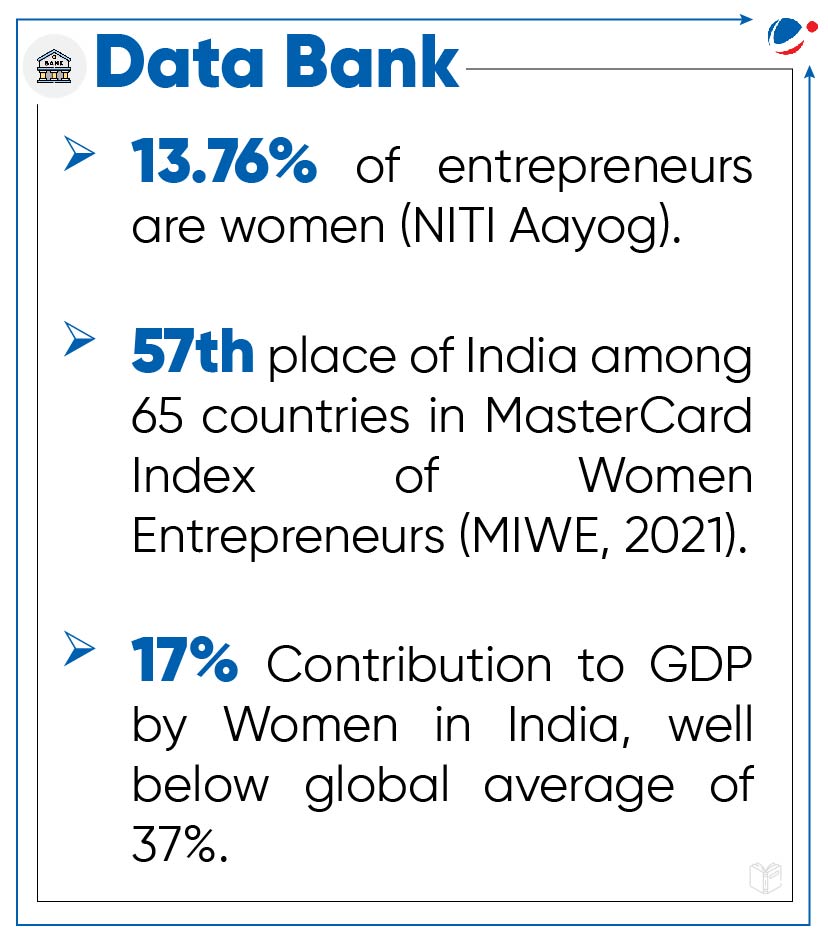Why in the News?
Recently Reserve Bank of India's Innovation Hub (RBIH) released a white paper titled 'At the Helm: Women Entrepreneurs Transforming Middle India.'

More about News
- This study is aimed at understanding complex socioeconomic dynamics affecting women's entrepreneurship in Middle India.
- In Middle India (i.e. Tier II and Tier III cities), women entrepreneurs are poised to play a transformative role.
- Despite notable progress in education and legislative measures improving workplace conditions, women's participation in entrepreneurship remains limited, particularly in Tier II and Tier III cities.
- This underrepresentation is a gap that demands immediate attention and dedicated action.
Significance of Women Entrepreneurs in Middle India
Economic Significance:
- Sustainable economic development & Employment Generation: By accelerating women's entrepreneurship, India could create more than 30 million women-owned enterprises, potentially creating 150 to 170 million jobs (NITI Aayog).
- Poverty Alleviation: India could increase GDP growth by 1.5 percentage points by including 50% of women in the workforce (World Bank). This also leads to sustainably augmenting family income.
Social Significance:
- Gender equality: Women entrepreneurs help in bridging the gender gap in the business world, promoting gender equality.
- Only 19.2% of Indian women participate in the workforce, in stark contrast to 70.1% of men, highlighting a significant employability gap of 50.9% (ILO).
- Fuller Utilization of human capital: The female labor force participation rate is merely 41% compared to 60% LFPR of men according to PLFS for the calendar year 2023.
- Developing local markets: Women entrepreneurs also tap into the global market using digital and social platforms.
- Example: The Splendor of Kashmir: Started by Varuna Anand from Jammu to promote Kashmiri shawl artistry through online sales and exhibitions across India. Her online sales venture helped her connect to a wider audience.
- Role Models and Agents of Social Change: Women entrepreneurs inspire other women to embark on their entrepreneurial journeys.
- Example: Maa Bimaleshwari Janhit Karya Samiti: A Self Help Group started by Phool Basan Yadav, empowering 200,000 poor women.
- Women Empowerment: By providing women with financial independence and decision-making authority.
- Example: Usha Jha: Affectionately known as 'Usha auntie' in Patna, supported women with entrepreneurial aspirations.
Challenges faced by women entrepreneurs in Middle India
- Capital Gap: Merely 3% of the women surveyed had accessed external funding, such as bank loans or equity investments, to start or expand their businesses.
- Data Gap: Lack of gender-disaggregated data hampers the ability to present compelling business cases to investors or lenders.
- Visibility Gap: Women entrepreneurs frequently confront societal undervaluation of their work, often stereotyped by their roles within the family or judged by their age or level of ambition.
- Safety Gap: Cities deemed safer for women usually have more entrepreneurs. Enhancing women's safety can directly contribute to fostering a more vibrant entrepreneurial ecosystem.
- Network Gap: Women face the challenge of rebuilding their social networks after migration due to marriage. This disruption often leads to slower career progression, as rebuilding networks takes time and effort.
- Marriage is the primary factor behind women's migration with 87% of women's migration being due to marriage.
- Care Gap: Women entrepreneurs are more likely to experience pauses in their careers due to caregiving responsibilities, including maternity leave and other family care needs.
Way forward and policy recommended by white paper
- Gender-disaggregated data: It is needed at a granular level to counter stereotypes, create interest in this segment, and make effective policy interventions based on data.
- The use of Local role models who have crossed these milestones plays an important role in developing an enabling environment. New urban infrastructure in Tier 2 India, such as airports or convention centers can be used to showcase success stories of local entrepreneurs.
- Access to capital: Provide grants to women entrepreneurs and female-focused Venture Capital funds to break the vicious cycle of women-owned businesses not scaling because of lack of funding.
- Fiscal incentives to female-owned businesses for childcare leave and expenses are a potential solution.
- Providing co-working and co-building space: Many women are not able to expand their enterprises because they operate from home and often limit their operations for as long as possible.
- More responsive financial system: Going beyond PSL targets and setting KPIs for more inclusive investing and credit can be an effective policy approach.
Initiatives Taken
|






